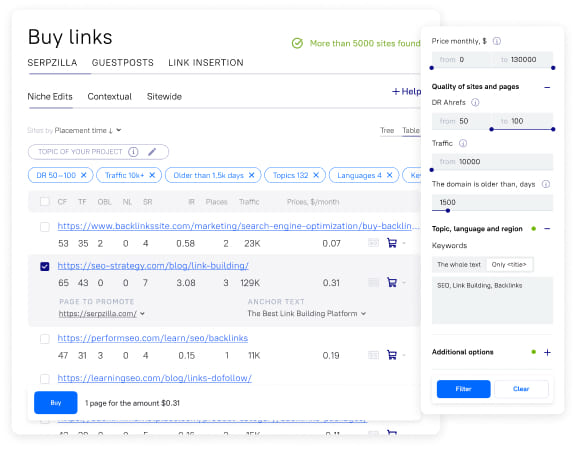For digital marketing experts, anchor text should be no mystery. It takes center stage as the most visible and clickable text within your chosen hyperlinks. It not only enhances the aesthetics of a webpage, but also serves an essential role in providing context to both users and search engines regarding the linked page’s content.
The importance of optimizing anchor text lies in its potential to influence a page’s relevance to specific keywords, thereby impacting search engine ranking. Search engines, like Google, utilize this cue from you to be able to decipher the content behind the all-important link, making anchor text a foundational aspect of any SEO toolkit.
Yet, the art of properly utilizing anchor text goes beyond the simple practice of mere keyword insertion. Anchor text optimization demands a strategic and contextual approach, pushing for alignment with your broader content strategy. Without a specific pathway into anchor text placement, the indiscriminate use of anchor text can carry harsh penalties. We are therefore left with one other choice: focusing on a measured and thoughtful utilization of keywords.
Thus, anchor text doesn’t lie in handling visual appeal, it’s a dynamic component capable of highly boosting your website visibility, credibility and ranking in search engine results – just remember to employ it wisely. As we navigate through this guide, we’ll fully uncover the main strategies that can elevate your backlink game and amplify online presence.
Types of Anchor Text: Crafting a Strategic Backlink Arsenal
In understanding anchor text placement, you should aim to understand the nuances of each type. Each serves a distinct purpose, offering the power to influence your website’s SEO ranking in several unique ways. Let’s look a little deeper into each category, focusing specifically on strengths and weaknesses.
1. Exact-Match Anchor Text:
This one is particularly straightforward, incorporating the precise keyword or keyword targeted phrase for search engine ranking. By being so direct, it informs search engines explicitly about the linked page’s content. The most basic type of anchor text, these are effective in moderation. However, do not trigger penalties by overusing them.
2. Partial-Match Anchor Text:
Partial-match anchor texts focus on balance by including mixes of the primary keyword or additional words alongside the main keyword choice. This approach balances keyword optimization with a more organic link profile, negating the risk of penalties for over-optimization.
3. Branded Anchor Text:
Branded anchor texts show the brand name as the anchor, which contributes to wider brand recognition. These texts are generally deemed as safe by search engines, particularly as they appear organic and are less likely to be used manipulatively.
4. Naked URLs:
Naked URLs focus on using the raw URL as the anchor, such as ‘www.serpzilla.com.’ Though straightforward and generally safe from penalties, they offer less contextual information to search engines compared to keyword-rich anchors that can be more useful for directing users to your content.
5. Generic Anchor Text:
When applying generic anchor texts, things like ‘click here’ or ‘read more’, remember that these lack any specificity regarding the linked page’s content. However, it’s important to understand that they contribute to anchor text diversification, presenting a more natural appearance to search engines.
6. Image Anchor Text:
When images are linked to your site, search engines focus on the ALT attribute as the anchor text. This algorithmic method effectively incorporates keyword strategies, whilst diversifying anchor text. However, ensure your ALT text is relevant and descriptive.
7. Long-Tail Anchor Text:
Long-tail anchor texts, those forming sentences or questions, offer a unique level of specificity and context. Though they are less frequent due to their length and difficult placement, they can provide a high level of detail and indication.
By incorporating a balanced mix of these anchor text types, you can create a natural yet diverse backlink profile. One that signals to search engines that you link building strategies are authentic and organic, a strategy which aims to enhance user experience and provide value while optimizing for search engine success. Balancing these elements ensures a robust foundation for your SEO strategy.
The Significance of Anchor Text Variety in Backlink Strategies
As SEO experts know, figuring the right metrics is a careful dance – cultivating a diverse anchor text profile is the rhythm in this metaphor – everything must be natural, yet organized. Search engines, such as Google, consider anchor text as a crucial indicator of a link’s context and relevancy to the target page. Yet, over-optimization can spell similar trouble, possibly marking your site as spam. Here’s why it matters:
1. Avoids Penalties:
Over-usage of exact-match anchor text can set off search engine alarm bells, signaling the use of unnatural link building practices. There, a varied anchor text profile is necessary, presenting a more organic appearance and reducing the likelihood of search engine penalties.
2. Improves Contextual Relevance:
Diverse anchor text types can offer varied contextual clues about a linked page’s content, helping search engines in accurately ranking your page for those relevant queries.
3. Enhances User Experience:
Diversified anchor text strategies tend to contribute to a better user experience. Descriptive anchor texts can provide users with a clearer preview of a linked page, lowering bounce rates and boosting engagement.
4. Strengthens Link Profile:
A robust link profile, encompassing a mix of branded, exact-match, and partial-match anchor texts, signals to search engines that your site’s link profile is natural and not artificially constructed.
5. Mitigates Risks:
As the old adage goes, don’t put all of your eggs in one basket! Relying solely on one type of anchor text is a precarious strategy. A diverse strategy spreads the risk, moving towards and organic profile, safeguarding your rankings in the face of search engine changes or shifts in algorithms.
6. Targets a Broader Set of Keywords:
Diversity is key. Ensure variety so that you can target a broader spectrum of keywords, including the valuable long-tail keywords. This organic versatility attracts more targeted traffic to your site.
In essence, a well-crafted anchor text optimization strategy focuses on diversity as a strength, balancing well with search engine algorithms whilst protecting your site against potential mistakes. This is a well-tested approach that not only boosts SEO, but also contributes to an enriched user experience. This will create a sustainable and resilient digital presence for your site.
Crafting the Perfect Anchor Text: A Strategic Guide
In the intricate dance of SEO, selecting the right anchor text is a pivotal step in ensuring your backlink strategy aligns seamlessly with your broader SEO objectives. The ideal anchor text is not just a clickable link; it’s a nuanced descriptor that adds value to the user experience while boosting your site’s authority. Here’s a strategic guide to help you choose the right anchor text for your backlinks:
1. Understand the Context:
In this arena, relevance is key. Your anchor text should offer a clear understanding of the linked page’s content. Avoid vagueness or misleading phrases that may not align with the target page’s material. The key here is to direct as clearly as possible.
2. Keep It Organic Yet Varied:
Focus on implementing diversity in your anchor text selection. For example, using a mix of branded, exact-match, partial-match, generic, and naked URLs can work to prevent over-optimization, creating a backlink profile that is authentically natural and organic.
3. Use Keywords Carefully:
While including keywords in anchor text can boost your SEO game, try not to overuse exact-match keywords. Striking a balance between keyword-rich, branded, and generic variations ensures an effective, all-round strategy.
4. Consider Link Placement:
Your anchor text should perfectly integrate alongside your surrounding content, fulfilling both user experience and a natural extension. Avoid placements that may feel forced: focus on the customer experience here.
5. Length Matters:
Whilst Google doesn’t publish specific rules on anchor text length, you should aim for optimal yet descriptive wording. This ensures that you strike a clear balance, providing both users and search engines with the optimal understanding of your linked page’s content and relevance.
6. Leverage Branded Anchor Text:
Focus on incorporating branded anchor text in a way that can strategically bolster brand awareness. Not only will this diversify your anchor text profile, it may also add an additional layer of SEO security.
7. Avoid Over-Optimization:
Whilst it may seem wise to focus on maximizing anchor text opportunities, repetitive use of the same anchor text will trigger spam filters. Proactively focus on monitoring your anchor text distribution, ensuring it remains organic, varied, and natural.
8. Test and Analyze:
Routinely assess the performance of your backlinks using tools like Ahrefs, SEMrush, or Serpzilla.com. Key analytical insights into anchor text distribution and its any link with your site’s ranking can guide adjustments to your strategy, geared towards success.
By considering these aspects, you can create anchor text strategies that not only enhance the relevance and authority of your backlinks but can also contribute to your site’s SEO performance. Anchor in both strategy and finesse, your chosen texts can become powerful allies in the pursuit of digital prominence.
Understanding How to Acquire Optimized Anchor Text Backlinks
In your own SEO journey, acquiring backlinks with optimized anchor text is a tactic you will eventually come across. Not only does this save time, but it also allows for you to optimize your anchor text strategy in a more direct manner. Here, we unveil a set of strategies to boost your journey towards securing backlinks with optimal right anchor text placement:
1. Content Creation and Promotion:
Focus on crafting compelling, valuable content that can naturally attract backlinks. This content should be relevant – think, anything from guides, infographics, or research studies. Focus on creating assets that resonate with your audience fully. Amplify your content’s potential reach through social media platforms and email marketing, enhancing visibility and backlink potential.
2. Guest Blogging:
Proactively contribute articles to credible sites in your niche, ensuring the anchor text is not only relevant but adds substantial value to the content. Guest blogging serves as a proven and organic route to secure backlinks with optimal anchor text.
3. Broken Link Building:
Identify any broken links within websites and offer free content as a replacement. In the spirit of collaboration, this strategy aids site owners into fixing broken links while securing a backlink with your customized anchor text.
4. Resource Link Building:
Should your website have valuable resources or tools, focus on outreach with other sites that have similar listings. Again, in the spirit of collaboration, you can offer to share your resources, fostering natural, relevant backlinks with appropriate anchor text.
5. Influencer Outreach:
Focus on creating healthy connections with influencers and industry leaders. Either collaborate on context or seek their endorsement – this can result in high-quality backlinks perfectly placed alongside natural and relevant anchor text.
6. Internal Linking:
Focus on the power of internal links when optimizing your anchor text. Seamlessly guide users and search engines towards your crucial pages, enhancing the overall navigational experience.
7. Proactively Monitor Your Anchor Text Profile:
Regularly utilize SEO tools to scrutinize your anchor text profile and understand where improvements can be made Ensure diversity and natural distribution, adjusting your link-building strategy if an over-reliance on specific anchor text types is identified within your strategy.
8. Competitor Search:
Examine your competitors’ backlink profiles to gain an insight into their anchor text strategies, understanding where they are succeeding in comparison to your site. This analysis not only provides industry standards engagement but shows new link-building opportunities.
9. Compliance to Guidelines:
Adherence to search engine guidelines is absolutely essential for search engine success. Avoid manipulative practices like purchasing links or participating in link schemes, as they usually result in penalties that can cause permanent damage to your SEO progress.
Boost your SEO results! Link building has become fast and easy with Serpzilla. Buy quality backlinks on authority websites with high DR.

Conclusion
In short, anchor text optimization is crucial for SEO success. As we delved into various types and strategies, it’s clear that this tiny element holds significant power over website visibility and backlink optimization. Here, a blend of relevance, diversity, and user focus is key.
Adaptability matters too; proactively improve and constantly adhere to updated guidelines for lasting success. Let your anchor text not just secure backlinks but shape your own digital presence, ensuring your website remains relevant and credible within constant changes in the world of digital marketing.








